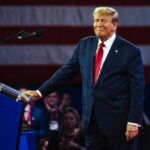U.S. President Donald Trump said in a social media article Wednesday that his administration will impose a 25% tariff on goods imported from India and fine the country starting August 1.
“Although India is our friend, we have done relatively little business with them over the years because their tariffs are too high, the highest in the world, and they have the hardest, most annoying non-monetary trade barriers for any country,” Trump wrote in a Truth Society post.
“They always bought the vast majority of military equipment from Russia and were Russia’s largest energy buyers and China, and everyone wanted Russia to stop the killings in Ukraine – everything was not good!”
Also on AF: India is now the largest source of US smartphone exports
Trump’s post came after a similar statement earlier this week, indicating that India’s tariff rates are higher and the trade deal remains elusive.
India’s rupee fell to its lowest level in Wednesday and five months after Trump’s statement on Tuesday said the trade deal with India had not been completed and the country could face steeper tariffs.
Trump told reporters on Air Force One that he added: “India has always been a good friend, but India basically charges more tariffs than any other country.”
This led to the steepest day-decline of the Indian currency since May, as it exchanged 87.5125 against the dollar before $87.42. The day fell by 0.7%.
The intervention was not very good, traders said, although the RBI may step in to support the local currency.
Trump’s decision has shattered a limited trade agreement between the two countries, which have been in talks for months.
U.S. and India trade negotiators have conducted multiple rounds of discussion to resolve controversial issues, especially in market access for U.S. agricultural and dairy products.

India opens to higher tariffs
Despite progress in some regions, Indian officials refused to open their domestic markets to import wheat, corn, rice and genetically modified soybeans, citing livelihood risks for millions of Indian farmers.
Indian officials said New Delhi has imposed tariffs on a wide range of goods and is working to alleviate non-tariff barriers.
However, agriculture and dairy products are still “not done” areas, and India is reluctant to import genetically modified soybeans or corn, or open up its dairy industry.
Reuters reported on Wednesday that India is preparing to accept tariffs of 20%-25% on exports to the United States without a trade deal. Indian officials insist on offering new offers ahead of Friday’s deadline.
Trump’s rhetoric on the India-Pakistan conflict has already had a shadow on trade talks, analysts say.
On Tuesday, Trump reiterated his claim that he helped the conflict between India and Pakistan earlier this year, saying both sides accepted his request.
“That’s great,” he described his friendship with Prime Minister Narendra Modi. India has disputed Trump’s claim that he has led to a ceasefire.
The Indian Ministry of Commerce, which leads trade talks with the United States, did not immediately respond to a request for comment on Trump’s latest social media post.
More tariffs
India is now joining more countries, with countries facing higher tariffs under Trump’s “Liberation Day” trade policy aiming to reshape U.S. trade relations by demanding greater reciprocity.
Trump said on Monday that most partners who do not engage in separate trade deals will soon face tariffs of 15% to 20% on U.S. exports, much higher than the 10% tariff he imposed in April.
His government will soon inform about the new “world tariff” rate of about 200 countries. The Trump administration has set an August 1 deadline to seal the trade deal to prevent higher tariffs.
The White House had previously warned India about its high average application of tariffs, nearly 39% of agricultural products, vegetable oil climbed to 45% and interest rates for apples and corn at 50%.
Although Prime Ministers Narendra Modi and Trump promised earlier to end the first phase of the trade deal until the fall of 2025 and to expand bilateral trade to $500 billion in 2030, up from $191 billion in 2024.
In 2024, the U.S. manufacturing exports, worth about $42 billion, and energy exports such as liquefied natural gas, crude oil and coal, may also face retaliatory actions if India chooses to respond in a physical manner.
Indian officials have previously said they see the United States as a key strategic partner, especially in balancing China.
New tariffs are expected to affect India’s exports to the United States, with an estimated $87 billion in 2024, including labor-intensive products for clothing, pharmaceuticals, gems and jewelry, as well as petrochemicals.
The United States currently has a trade deficit of $45.7 billion with India.
Other pressures of rupees
The Indian currency has been losing money since the Trump craze began, as trade agreements between India and the United States remain under pressure and remain elusive.

The pressure on the rupee puts hedge against the rupee’s hedge, said Dilip Parmar, forex analyst at HDFC Securities, said Trump’s tariff threat, the psychological impact of the rupee’s violation of the 87 mark and the urgency of the hedge before the August 1 deadline.
Parma said the rupee could drop below 88 in the next few weeks if conditions remain unchanged. Local units reached an all-time low of 87.95 in February.
Apart from trade uncertainty, the ongoing foreign portfolio outflow is also a pain point for the rupee. Overseas investors sold $1.5 billion in local stock in July.
A trader at a foreign bank said the prudence and lack of inflows between importers put pressure on the currency, which could continue in the near term.
Meanwhile, the dollar index barely changed to 98.8 as investors awaited a mixed trading of Asian currencies as they waited for the Fed policy decision later that day.
There is a general expectation for the Fed to remain unchanged interest rates, with the focus on comments from Chairman Jerome Powell and whether the decision is consistent.
- Reuters, other editors of Vishakha Saxena








